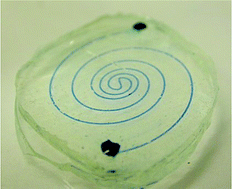Fluid mixing in planar spiral microchannels
Abstract
Mixing of fluids at the microscale poses a variety of challenges, many of which arise from the fact that molecular diffusion is the dominant transport mechanism in the laminar flow regime. While considerable progress has been made toward developing strategies to achieve improved mixing in microfluidic systems, many of these techniques introduce additional complexity to device fabrication and/or operation processes. In this work, we explore the use of compact spiral-shaped flow geometries designed to achieve efficient mixing in a format that can be constructed using a single planar soft lithography step without the need for multilayer alignment. A series of 150 µm-wide by 29 µm-tall channels were constructed, each of which incorporated a series of spiral shaped sections arrayed along the flow path. Five spiral designs with varying channel lengths were investigated, and mixing studies were carried out at flow rates corresponding to Reynolds numbers ranging from 0.02 to 18.6. Under appropriate conditions, transverse Dean flows are induced that augment diffusive transport and promote enhanced mixing in considerably shorter downstream distances as compared with conventional planar straight channel designs. Mixing efficiency can be further enhanced by incorporating expansion vortex effects via abrupt changes in cross-sectional area along the flow path.


 Please wait while we load your content...
Please wait while we load your content...